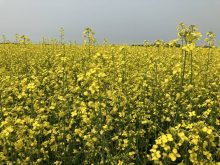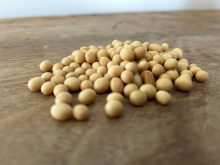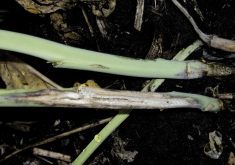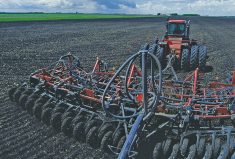Resistant canola varieties have played a major role in the war on clubroot but they are not enough on their own, say agronomists.
An effective fight against the soil-borne, canola-targeting disease requires several solutions and fall is the time to think about them.
“Because clubroot is such a complex disease, it’s really important that we acknowledge that it will need a complex solution to manage it,” said Marissa Robitaille Balog, an Agronomy Specialist with the Canola Council of Canada.

“(Resistant varieties) are not a fix-all solution, so we need to be stewarding them carefully to make sure that we have them available for the long term, which is why scouting for disease presence or resistance breakdown is so important.”
Read Also

Hail research hopes to benefit potato growers
Alberta research scientist measures hail storm and heat dome affects on potato crops
Clubroot is a disease of cruciferous plants. Its galls tie up nutrients and in extreme cases will prevent canola roots from delivering sufficient water and nutrients to the plants.
When it arrived in Alberta two decades ago, clubroot quickly found a home in acidic central Alberta soil where it thrives, said Tom Ernst, a researcher with Corteva Agriscience.
“If you look at the Edmonton area where it was first found, you get slightly more acidic soils than, say, further down south. That helps facilitate the establishment of the disease.”
However, producers who grow canola in alkaline soil shouldn’t be complacent. The disease has mutated, said Ernst, so different strains of clubroot can affect those soils as well.
“People hypothesized that it’s not spreading down (south) or maybe our soil pH is high enough that we’re going to avoid getting it. And it’s not exactly the case.
“We’re finding there’s enough diversity in clubroot that there are pathotypes that will infect crops in higher pH situations.”
Fall is an excellent time to scout for the disease, he said.
“If you come into an area of your field that has lower yields and it’s confusing, why not get out and pull some plants? If you pull a plant and it has galls, then you know it’s there. If you know where it is, that helps you manage it a little bit better. You can avoid those areas, maybe work them last in the process of planting next year.”
Robitaille recommended scouting multiple parts of the field, not just the field entrance.
“If your field has multiple entrances, really focus on those high traffic areas or areas that are really prone to moisture, keeping an eye out throughout the growing season for any prematurely dying patches that may be susceptible to clubroot.”
Post-harvest is also ideal for soil sampling. If galls are found while scouting, the next step should be a soil test, said Robitaille.
“We highly suggest soil testing to determine if there is clubroot DNA present.”
Sampling is also a key tool to check whether spore loads are low enough for seeding canola the year after planting a non-canola crop. Wheat, for example, can’t spread clubroot but the movement of soil with equipment can carry it.

“You’ll want to check to see if your spore loads are low enough by collecting soil samples after harvest and seeing if it’s up to standards to go into canola cultivation in the following year,” said Ernst.
Some producers use soil amendments or liming to raise soil pH so it’s less susceptible to clubroot, but those can be expensive options, he said.
“None of that’s really taken off on any large scale. It’s a little bit cost-prohibitive.”
Controlling clubroot doesn’t work in a vacuum, said Robitaille.
“Controlling fall weeds that may possibly serve as a host for a clubroot pathogen is important.”
Much of fall/winter clubroot management will be done around the kitchen table, strategizing for the coming growing season. One of those considerations may be the painful — but ultimately beneficial — decision to not plant canola in clubroot-infected fields for two years.
“The recommendation of a two-year break between growing canola can’t be understated in terms of its effectiveness,” said Ernst.
“Field-based data from Alberta shows that if you can extend your rotation from a one-in-two to a one-in-three canola rotation, you can help bring down the clubroot resting spore load in the field by about 90 per cent.”
Virtually all canola growers recognize the value of rotating crops, but what about rotating canola varieties or genetics? This has become a recommended practice as well, said Robitaille.
“If you’re growing a resistant variety and you’re seeing breakdown happening in the field, that’s an indication that you need to be switching genetics,” she said.
“Pathotypes in the field are often diverse and there can be multiple pathotypes present at once. As populations become more diverse and we’re able to breed more clubroot resistant genes and varieties, the usefulness of rotating different varieties will definitely increase.”
















